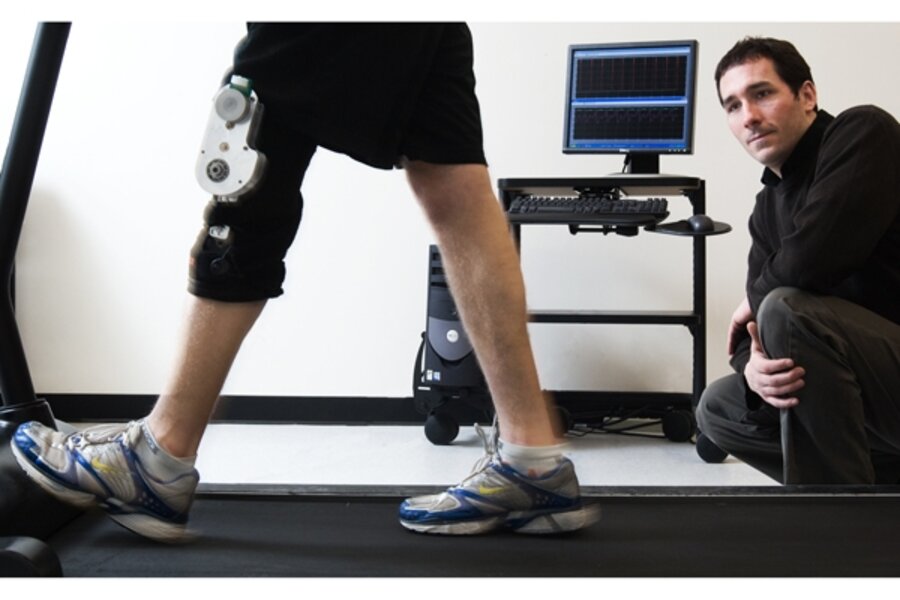These batteries are made for walkin’
Loading...
| Toronto
Soldiers on the battlefield and aid workers in remote outposts may soon be able to recharge their mobile phones simply by walking, thanks to a device being developed by Canadian researchers.
The Bionic Energy Harvester attaches to a knee brace, capturing energy with each step. One minute of walking can generate 10 minutes of talk time on a cellphone.
“It would surprise a lot of people to know that there is a lot of power available from the knee joint during walking,” says Max Donelan, a professor of biomedical physiology and kinesiology at Simon Fraser University in Burnaby, British Columbia. “We’re taking advantage of energy that’s already being produced and wasted.”
The mechanism works much like the regenerative braking found in some hybrid cars, which capture kinetic energy that would otherwise dissipate as heat to drive a generator.
“Walking is a lot like stop-and-go driving,” says Dr. Donelan. In walking, the knee extends at the end of the stride and the hamstrings flex. The Bionic Energy Harvester helps the muscles slow the knee during the swing phase while capturing the energy. Gear trains drive the generator, altogether producing about 5 watts of electricity with each stride.
The 3-1/2-pound energy harvester only engages for brief moments at the end of the swing phase. “In that way it can produce a substantial amount of energy without adding any additional effort to walking,” says Donelan.
When the researchers tested the device, subjects on a treadmill didn’t notice using any extra exertion when it was turned on. Donelan was surprised to discover, however, that when he turned off the mechanism, the subjects did notice and in fact missed the assistance. “For three or four strides they swung their legs a little faster [than normal].”
Donelan and his team at Bionic Power, a company he set up to develop and sell the device, expect to double the output to 10 watts per step.
Bionic Power plans to deliver a slimmed-down two-pound version of the energy harvester to the Canadian military in June for field testing. Soldiers on a 48-hour mission carry up to 30 pounds of disposable batteries to power equipment such as radios, computers, thermal weapon sights, and range finders. The US military is also interested in the device.
A single disposable AA battery that sells for about a dollar at a store can cost $30 by the time it gets into the field, Donelan says.
“When you see the logistical costs of all those batteries in theater, you can see how soldiers and the Army are struggling to save electrons,” says Ed Andrukaitis, a scientist with Defence Research and Development Canada, an arm of the Ministry of National Defence that is helping fund the research. “We could run longer missions and basically consume [fewer] batteries.”
The military likes what it sees so far, he says, because the gadget produces significantly more power than other energy-harvesting devices. US researchers are working on a heel-strike method where shoes with special soles generate electricity when compressed.
At Arizona State University in Tempe, heavy backpacks with special straps connect to a generator. Early testing showed that the backpack could grab 45.6 milliwatts – enough juice for a cellphone to get one minute of talk time for every 10 minutes walked.
Defense scientists plan to incorporate Donelan’s device into a soldier’s uniform for field testing. Donelan declined to say how much he thinks it will eventually cost.
Soldiers are not the only people who depend on portable power. Emergency workers responding to disasters such as hurricane Katrina or the 2004 Asian tsunami also operate without a power grid. “First responders want to get into a site to help people and stay out as long as they possibly can, but relying on battery power can constrain that,” said Donelan.
Similarly, geologists, hikers, and explorers spend days or weeks off grid. People in developing countries without easy access to electricity could use the energy harvester to power cellphones and computers in schools.
Donelan knows his device provides just a small fraction of the energy humans consume. Global consumption works out to about 10 kilowatts a second per person, he estimates.
“Human power won’t replace other sources of energy, but we can use human power to cut down our use.”
One step at a time.





